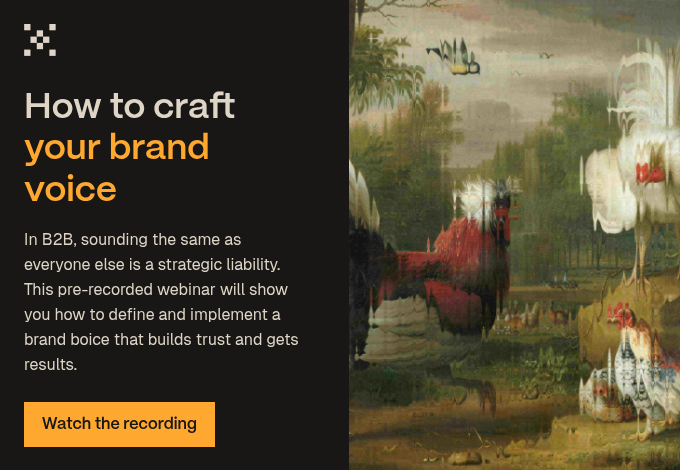A marketing strategy is a big beast. It encompasses everything from email marketing and content creation to PPC and website design. While each component is complex and important, they have to connect to be effective.
That’s where brand guidelines come in: they ensure your marketing efforts all work towards the same goal and gradually build up brand recognition among potential and existing customers.
What does an effective marketing strategy look like?
The ultimate goal in marketing is to generate successful leads: to do that marketing has to ensure your brand is noticed and remembered by the right people at the right time.
An effective marketing strategy can achieve this, but only if you have one thing straight: your brand.
As Aristotle said, ‘the whole is greater than the sum of its parts.’ Your brand is the whole. The elements of your marketing strategy are the parts that must combine to achieve the same end goal: to tell the world who you are and why you’re important.
You can initiate the best email marketing campaign and series of blog posts, but if they don’t align with each other and with your brand, it will jar. An inconsistent brand experience not only weakens your marketing efforts - it promotes distrust among your customers.
A study into the impact of inconsistency on brand loyalty showed that consumers lost trust for their favourite brands if they noticed something was different. Since it costs more to attract new customers than it does to nurture existing ones, no company wants to lose its loyal fans.
Brand recognition at a glance
Brand recognition is a rapid process. According to Nielsen, consumers only buy from a small repertoire of brands, and the average customer spends 13 seconds purchasing those branded items in store. In other words, when your customer scans the shelves, they reach for what’s familiar and they do it fast. This is known as ‘instinct buying’.
Say you’re looking for toothpaste. You immediately recognise Colgate on the shelf because it’s what you usually buy*, and so you buy Colgate. You don’t study the packaging to check if it’s Colgate – you just know. This is instinct buying, and this is why consistent brand recognition is so important.
But it’s not just in store that your brand has to be recognisable: your brand has to be instantly recognisable in any format. Take the example below. Can you tell which company this eBook cover and website homepage belong to after just a quick glance?
 .
. 
Even without the company’s logo on show, the rounded font, the red colouring, and the words ‘delivery’, ‘mail’ and ‘postage’ all make it clear that this is Royal Mail. Despite the different formats, they both embody the same branding.
Brand mascots
Plenty of companies use brand mascots to breathe life into their brand and to create a brand community around their product or service. Here at Articulate our brand mascot Artie is instantly recognisable as our company ambassador.
From the Michelin Man through to the Jolly Green Giant brand mascots have ensured product recognition across generations. Just think of the influence that Tony the Tiger has had over the years as kids in supermarket aisles and over kitchen tables chime in acknowledging that Kellogg’s Frosties, well, ‘they’re grrreat’.
Brand mascots really help differentiate your business from the potential facelessness of the business world and they give you the chance to share a bit of your personality with your audience too.
Enter the brand guidelines
Brand guidelines are an excellent way to compile all the features that make your brand distinct into one document. Implementing those guidelines is what turns ‘musts’ and ‘must-nots’ into meaningful marketing. It’s what connects your email campaign and your blog series into one recognisable force.
What should brand guidelines include?
Your brand guidelines are a representation of what your brand should look and sound like to the public so they need to include everything that you value:
- A mission statement
- Fonts
- Heading sizes
- Logo colour
- Alternate logos
- Tone of voice guidelines
- Colour pallets
- Approved images
A good brand style guide pulls your marketing strategy together and ensures that every element works together. To make this all a little more tangible, we’ve gathered a couple of great examples of companies that have used brand guidelines to make their marketing strategy more effective.
Skype
Skype is a free piece of software that allows people to make phone calls all across the world from their computer or mobile phone. This is Skype’s style guide.
Why do we like it?
It’s fun, it’s informative and it sums up exactly who we know Skype to be. The tone is playful - ‘Never abuse our logo, it doesn’t have arms so it can’t fight back.’ – and it gives an outline of how Skype’s products should be explained:
Our products are always explained in the simplest terms. If your mum couldn't understand what is being written, then it's not the Skype voice.
Skype’s branding in practice
This is Skype’s homepage and Twitter profile. On both, the logo is familiar, the colouring is the same, and the tone is consistent and on point.


Google’s style guide is more visual than wordy, but it’s easy to understand.
Why do we like it?
It’s comprehensive without being overwhelming. It covers everything from the old icons to the new ones, the right colour sequence, and favicons by showing ‘correct’ and ‘incorrect’ images:

Google’s branding in practice
Let’s face it, Google is the king of the internet and we just need to see those four colours to know who we’re dealing with. Why? Because they’re used consistently across all Google’s marketing, especially with its apps.

Like most of the social networking sites, LinkedIn has a very distinct brand, it's strong colour choice and commitment to brand is probably why it's the 15th most popular social network site in the world.

Why do we like it?
LinkedIn is ALL about the user, they are all about inclusivity and trust. They have developed their brand positioning over the years to ensure that their platform is straightforward to use but is also focussed around building communities.
You can check out their brand guidelines here.
Brand matters
An effective marketing strategy needs a recognisable and consistent brand to promote. Customers need to know that when they see this colour with that font and this tone, it’s your brand. Whether you’re sending out newsletters or designing a landing page, they have to follow the same guide. If they don’t, the effort you put into your marketing strategy will amount nothing.
(*Other toothpaste brands are available)





.jpg?width=400&height=250&name=europeana-9N27AE6bAKc-unsplash%20(1).jpg)
